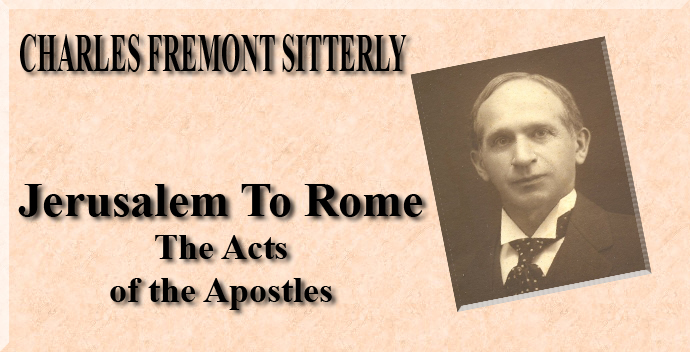
Jerusalem To Rome
The Acts of the Apostles
By Charles Fremont Sitterly
Preface
|
This book is a book of Acts; not of theories nor speculations, nor even of creeds, but of facts, of realities, of conquests, of travels, of preaching put at once into practice, of faith that works. After the Gospels, the Acts is the most fascinating book of the Bible. It is historical drama, with all the appealing power of such literature. The stage is the Roman empire. The scenes fall in the homes, market places, highroads, sea-lanes, temple precincts, and law courts of every province and chief city from Judea to the Capital. The actors include every social stratum from the lowest slave-girl to the Emperor himself, bringing forward kings, queens, prelates, soldiers, sailors, dyers, weavers, smiths, dagger-men, beggars, thieves, outlaws, magicians, mobs, and, above all, hosts of good, pious, plain people, and some saints. The time covers a single generation, that immediately following the crucifixion, from 30 to 63 A. D. The book has been discussed, dissected, and critically examined so completely in recent days that it is in some danger of being-buried beneath the tradition of the elders, not to say neophytes, of biblical criticism. As Professor Richard G. Moulton says of the Bible as a whole, “There still remains one thing to be done, namely, to read it.” Forasmuch as many have taken in hand the task of translating the New Testament into vernacular English, it seemed good to me also to make a contribution of this sort for two reasons: first, because it is only in our day that the Greek Text of the New Testament, and especially of Acts, has become settled; and, second, because we are in an epoch of new translations, and this one is offered as a specimen of what may be done toward feeling after, if possibly we may find, a common version in English for coming generations. Professor Alexander Souter’s admirable text (Oxford, 1910) is our basis. In order to let the reader, like noble Theophilus, enjoy the native power and simplicity of the work, we have cut the cords of medizeval versification and numbering and given the translation, with larger type, the place of honor on the right-hand page, as in Codex Beza. We have also freed the commentary from much material of a miscellaneous kind, condensing and presenting it in the form of lists and tables in the Introduction, thus making possible a certain continuity and directness to the comments. For illustration, we have selected a few of the best things in Christian art touching upon the story, and have had reconstructions made of the six chief centers about which the action revolves—Jerusalem, Antioch, Ephesus, Athens, Corinth, and Rome—where Christ and the New Way displaced in turn Moses and the Law, Apollo and License, Diana and Nature-worship, Minerva and Earthly Wisdom, Venus and Sensualism, and Mars and Military Might. CHARLES FREMONT SITTERLY.
Drew Theological Seminary,
|
|
 |
 |
|
|
|
-
Site Navigation
 Home
Home What's New
What's New Bible
Bible Photos
Photos Hiking
Hiking E-Books
E-Books Genealogy
Genealogy Profile
Free Plug-ins You May Need
Profile
Free Plug-ins You May Need
 Get Java
Get Java.png) Get Flash
Get Flash Get 7-Zip
Get 7-Zip Get Acrobat Reader
Get Acrobat Reader Get TheWORD
Get TheWORD